This last weekend we went on a 4 day camping trip with other VSA volunteers, a German girl and a Danish guy. 9 of us all up. 3 people had been to this place before which was just as well as it is not obvious at all. The place is called Lake Natron in the NW of Tanzania. Not far from Ngorogoro Crater which is the big famous national park. To get to Natron however is 100 km (60 m) off the tarmac road. It took 5 hours to drive that distance. Corrugated gravel road that shakes you to bits, that then turns into a gravel dirt road, then a dirt road dropping down through dry river beds, or crossing high planes. Fun driving but our poor little truck gets a rough time on these roads. It managed them really well overall. There were 3 other vehicles as well so we travelled in sort of a convoy. Bruce has a 4WD high ace van he has fitted out for Africa and so includes a large tool box just as well. About ¼ of the way in the rubber bushing on the top of his front right shock disintegrated allowing the shock to bang around. He dives into his tool box comes out with a set of tools and an old piece of car tyre and makes a new bushing. This lasted about another 1 hour then the metal shims that hold the rubber bushing on became pounded out and they and the rubber came off again. Bruce makes a new rubber and I find a 3/8” washer at the bottom of his box. This is quite a bit thicker than the metal shims so he puts that on and it holds the rest of the weekend just fine.
Then a bit more on Alan and Andrea get a puncture in their Landrover. Now we are hours from anywhere, no chance of getting any repair of the tyre. We put the spare on and Alan says at the end up by the lake there is a tiny village maybe we can get another tube there. So off we go again fingers crossed.
At one point we drive through the crater highlands. This is a high grassy plane, with mountains on both sides, except that now it is so dry that there is only stalks left. But there are these small craters from old volcanoes all over the place. Very cool scenery, hostile to life but beautiful to admire. This is also the heart of Maasai country. The Maasai are cattle and goat herders. They wander around the planes and mountains with their herds looking for food for them. They live in Boma’s which is like a collection of ½ dozen igloos made of mud. In this area there is extremely little water. The Maasai have learned to live without much water, they drink things like animal blood. As we drove along the road, some that were close to the road and seeing 4 vehicles drive along, would come running down to the road begging for any water. Money was not important to them like it is in Arusha or more normal places. They just wanted water. Quite a shock to the mind to see and learn this. The Maasai dress in the most beautiful colours. The men are wrapped in a tartan like red/black cloth and they all carry a spear or stick. The women are similar but wear all this ornate jewellery. Large earrings, multiple in each ear, intricate neck pieces. Very stunning to look at them. They have their own language too so we could not understand anything they said only when they indicted drinking something.
Also at this Lake Natron is Ol Doinyo Lengai Volcano. This is Maasai for Mountain of God. As we drove north we saw the mountain come into view. It is a very symmetric steep mountain all by itself about a mile from any other mountains. We had to drive past it to get to the lake and the camp ground. It is still an active volcano, last erupted in 2006 with a large amount of rocks and ash and sand. (No Lava). You could see from its slopes there were no trees or plants, just rock sheets and rocks and sand gullies that water had flowed down in. It is quite pretty really in an odd way.
We got to camp just at dusk and set up the tents, and found they had a swimming pool albeit a little green and they served cold beer and sodas. We were set.
They next day we spent a lot in the pool as the heat was impressive once out of the shade. Ramona walked off the grassy area that was the campground boundary out on to the edge of the lake bed (when the lake used to be that high, all just sand now) and wow was it hot out there. Back to the pool. There is a little town a km down the road that we were told may have a spare tube for Alan. The camp owner asked us while we were in town if we could bring his supplies back as he had just seen the bus go buy and he didn’t want them to sit around for too long. There would be a guide there too we could talk to he said about climbing the mountain. So off we went. Found a tube at an exorbitant price, but the vendor had us over a barrel. We bought that and went to find the guide and a cold coke in a little wooden shack. This was a Maasai town, about a dozen wooden buildings. The clothing was impressive all over, some women in the bright red with jewellery, some in black from a different tribe with different jewellery. Bruce bought a great Maasai spear for $15. There is no phones here, no TV, no news paper. This was their world and that was all they knew. But very friendly people. They were selling all sorts of trinkets and jewellery very cheap. We arranged for the guide to meet us at 11 pm that night. They days are too hot, especially climbing on black rocks and sand, to climb during the day. So we were to do a night climb.
At about 5 pm we drove around to the lake bottom to a point where we could access the lake to see the Flamingos. The lake is low so there was about ½ mile of dry sandy mud to walk from the car stop point to the water’s edge. It is an alkaline lake too, so nothing grows, quite a stark arid area. Then there are these beautiful pink delicate big Flamingos by the 1000. Everywhere. A group here another over there etc. The horizon on the lake was just a pink band. Some were landing, some were taking off, others feeding or talking. The contrast of the aridness to the colourful birds was just so impressive.
We tied to get an hours sleep after dinner that night but not too successful. Got up at 11 and drove to the camp gate where the guide or actually the guide’s substitute was waiting for us. He said in broken English he was the guide’s brother and his brother was sick. Not good, the original guide was very experienced and spoke quite good English. Alan was saying this was a set up, to take our money and not do the climb. We talked with him some more and noted he had bought some climbing sticks with him for us to use which we took as a good sign, so we decided to take the risk. It was about 30 mins drive to the base of the mtn. Along the way we chatted some more to him in broken English and got to feel better about the situation as he seemed to know what he was talking about. He had bought a 2nd guy to stand security on the Landrover while we were climbing. We started climbing at midnight. It was a starry night, clear with a cool breeze blowing which made it a great night for a climb. We were walking on sandy trails or sandy rivulets in between sheets of rock from previous eruptions. The higher we got the more steep it became. The sand made climbing tiresome slipping backwards all the time. At 3:30 Ramona and Alan said they would stop there as it was getting more and more difficult to make progress. They nestled down behind a big rock out of the wind and waited for us to return. The guide made sure they understood to not move away from this area. He said it was too dangerous to attempt to walk down in the dark; we had to descend in daylight. Alan is quite an experienced climber which made me feel better about them stopping there by themselves. That left myself, Yong and the guide to go further on. At about 4:30 the going was steeper still and the sand and rough rock plates were making harder and harder to get a footing on. Yong said he was so tired that he just wanted to go to sleep, so he said he would stop there. It was still another 2.5 hours to the top the guide said. Poor Yong however was on a steep part and could find no flat space too lie down, so he sat down and propped himself up with his walking stick so he wouldn’t fall over when he fell asleep.
There were two other groups on the mtn too. They had started after us and had passed us earlier on so we could see their lights up the mtn. The guide and I carried on, we passed one group, then the second group as they had stopped for a rest. Once they started again they soon passed us. A fit Canadian couple with a guide. As we neared what looked to be the top rim there was a little bit of damp soil like stuff around and it made climbing on the rocks slippery. It was steep enough now that often I was climbing on all 4s to grab rocks and lift my feet up trying not to slip. Still a lot of soft sand in the gullies between the rock plates. By now I was rather tired. The sun had just come up so the head lamps could be turned off. Approaching the rim I could now see these two great rock structures like a gate way with a gap between them. We were heading for the gap. That must be the top I thought. However as we got within a 100 meters, I could see there was yet another ½ mile (1 km) more of rock and sand to go up beyond this gap. My heart sank; the 7 hours of exertion were taking their toll. That would take at least another hour or more. The guide was 10 m in front and once through the gap he turned left and disappeared from sight. I got to the gap a few minutes later and turned left too, to find a gentle ridge going up about 70 meters to where it turned to the right into the top ridge around the crater and that was quite flat. My joy soared we didn’t have to climb that ½ mile of sloping rock after all. It was now very easy walking on the rim. I could finally get the camera out and take some pictures. The top was a series of depressions and the main crater with a thin rim between them all. One side of the rim would fall down the mtn, the other side of the rim would fall into the crater or one of these other depressions. The rim was about 4 ft wide so it was quite safe and easy to walk along. The crater was about 1 km wide. On the inside the rim sloped steeply down for about 100 m then a sudden 100 m deep drop off down to the bottom of the crater. You could see steam, smell a bit of sulphur, and see rock that had cooled from lava extrusions. Pretty cool stuff.
The outside of the rim fell away steeply on all sides. With the sun just up and low on the horizon, the whole mtn cast a perfect symmetric shadow on the big escarpment cliff about a mile away. That made for a nice picture.
Then came the going down, not something I was looking forwards to. The Canadians had left to go down about 15 mins before us. The third group was still coming up. The rock plates were too slippery to walk on top of let alone try to step down on them, so it meant walking in the sand gullies between the rock plates. These gullies or rivulets were from 1 – 4 ft deep and 1- 4 ft wide. The sand was not slippery like the rocks but you could easily slide down with all the sand around your boot sliding down to. So the process was to take the walking stick, stick it in the sand or a crevice about 2 ft in front, then step down to the stick with one foot, if that held, then step down with the other foot while hanging on to a rock edge on the edge of the rock plate with the remaining hand. Then repeat over again. A slow but steady process. I knocked a few rocks loose and we had to yell out to the Canadians about 100 yds in front of us below to ‘Look Out’ as that can be very dangerous. Once going, those rolling & bouncing rocks do not stop for ages. The further down the less step it got and easier to walk.
It took about 4 hours to go down, picking up Yong then Ramona and Alan along the way. By then it was near 11 am and the heat was in full force. Needless to say the afternoon was spent in the pool in the shade with cold cokes and beers.
It took 4-1/2 hrs to drive out again the next day, passing Zebra, Ostrich, Jackals’, etc. This time we had filled up all our empty water bottles and handed them out to the Maasai people who came up to the road as we drove along. Some were so excited to get water.
About ½ way out, there was an ancient stone ruins site off the way so we went to that for a short diversion. About 500 yrs old, it was occupied by some people pre Maasai. People called Songo they thought, whose relatives now live way up north of Lake Natron. Not a lot of details known as there was no written language amongst those people pre-European.
Subscribe to:
Post Comments (Atom)
































































































































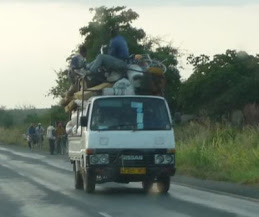





























































































































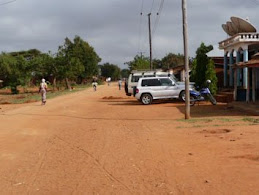

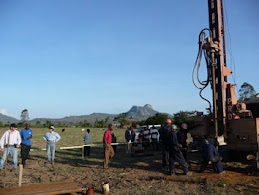


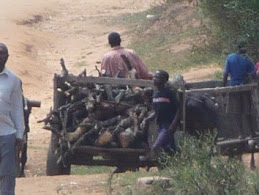
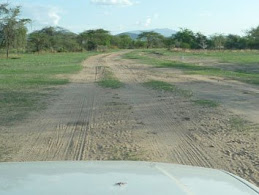























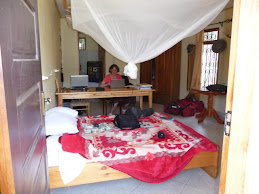

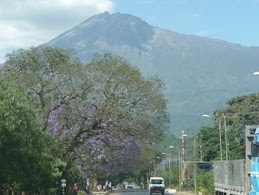
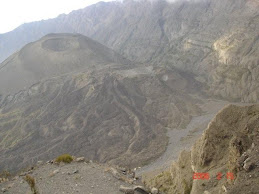
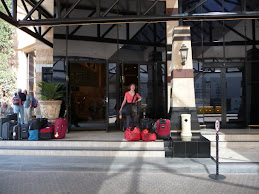
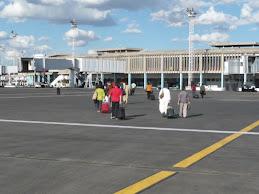
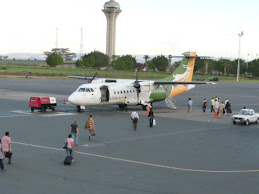
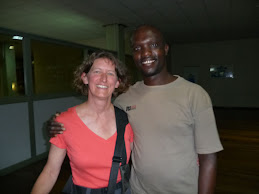
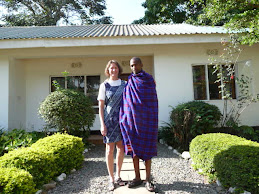
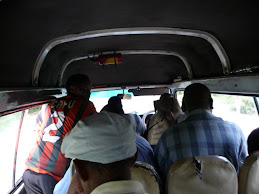


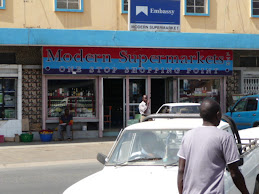





No comments:
Post a Comment